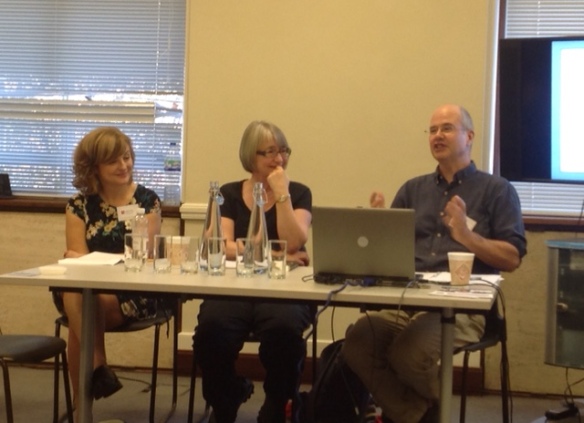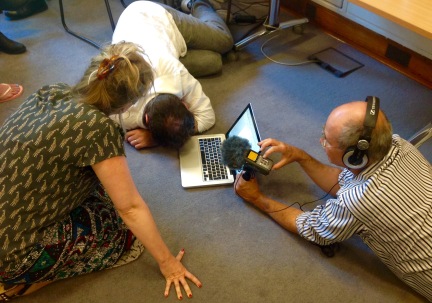Over two days, Migrating Texts brought together 17 expert speakers, four panel chairs, and a wide range of attendees from academia and the cultural and creative industries to discuss subtitling, translation and adaptation. We’re incredibly grateful to all those who came and contributed to the conversation. For those who couldn’t make it, over three blogs we’ll be bringing you the main points from each session. Last but not least: adaptation.

L-R: Melanie Stokes, Gwyneth Hughes, Jeremy Mortimer
The adaptation session began with a panel of industry professionals discussing their adaptations of Dickens to film, radio and television. Our first speaker, Gwyneth Hughes, explained that you have to pitch based on your ability as a screenwriter to stand up to the greats like Dickens. In adaptation you have to be prepared to kill your darlings. You have the genius on your shoulder, but your employers just want to make money and don’t care much for fidelity. Huge casts of characters and lavish settings just aren’t affordable. Gwyneth called Edwin Drood, which she has written a screen adaptation of, THE great unfinished novel. Everyone has an idea for it, but you have to do what’s possible. The biggest challenge in adapting a classic is how to get across what people are thinking and feeling: “In novels you’re inside people’s heads. On telly you’re outside someone’s face”.
Jeremy Mortimer, who has produced over 200 radio dramas for the BBC, explained how the way that the BBC has changed its time-slots has changed approaches to adaptations, especially the introduction of the 15 minute drama slot. In the 80s, the approach was big books over many many episodes. A Tale of Two Cities in 1989 was 7 hours long, whereas the 2011 version had only 3 hours. Jeremy equated this process to how Dickens himself had to adapt his writing to publishers’ needs, with the beginning of Barnaby Rudge published long before Dickens wrote the end. While novels are often written in the past tense, radio adaptations have to be in the present because “A novel is what happened whereas drama is absolutely now”. Unlike TV and film, radio allows much greater use of a narrator and has no restrictions in terms of settings (so the latest verion of Barnaby Rudge starts in the modern day Middle East). Jeremy affirmed that casting is an important part of the adaptation process as it affects how people experience the text. He therefore cast Daniel Laurie, an actor with Downs syndrome, as Barnaby because he didn’t want to direct an actor pretending. He ended with the assertion that every adaptation, even The Muppet’s Christmas Carol, adds to our collective idea of what Dickens means. As long as you preserve the essence of Dickens (his impressionist style, his care for his characters), you are doing Dickens.
Our final speaker in this panel, Melanie Stokes once presented “Not As Good As the Book” for Channel 4, in which she concluded that all adaptations are personal readings. Film, she argued, is more like real-life. Time never stops and you can never know what’s in someone’s head. You have to be very careful using literary devices for the screen: voice over can be the death of the story as it loses urgency. Pacing is absolutely key in films. What makes someone like Danny Boyle a great director is that he makes films like music. Dickens, Melanie maintained, is tragicomedy, but he’s as messy as life: with romance, grotesque, silliness,and sinister villains. Modern audiences aren’t used to such a mish-mash of genres, so the biggest challenge is how to set the tone, “like streaky bacon”. Melanie argued that, in a way, new approaches to period pieces say more about our world than contemporary works. Nick Nickleby is the first contemporary adaptation of Dickens for TV. Inspired by Sherlock, it used excerpts from the original text, bleeding time periods together. The orphanage was updated to the scandal of old-people’s homes, a modern problem that Dickens would have been interested in.
In the Q+A, Kate Griffiths raised the question of authorship. Gwyneth Hughes said there would be no product without an enormous team. Melanie Stokes added that the job of the producer is to protect the writer’s vision but it depends on the alchemy of the team. As for why contemporary audiences remain drawn to Victorian texts, Melanie Stokes suggested that the Victorian feels like it’s “us” as it’s the start of modern Britain so it doesn’t need updating. Gwyneth Hughes agreed that these Victorian stories are so exciting because there was so much on the line for people back then. “Telephones and high-speed trains ruin much of the drama of 19th century stories” Jeremy Mortimer quipped. Finally, in response to a question about the relationship between academic experts and writers, Gwyneth Hughes replied that she does obsessive research for her adaptations in a very scholarly way rather than consulting an outside expert.

L-R: Kit Yee Wong, Prof. Dan Rebellato, Dr Andrew Watts, Dr Kate Griffiths
The second adaptation session focused on adaptations of Zola and Balzac across different media, from an academic, analytical point of view. Professor Dan Rebellato (Royal Holloway) began by introducing the latest BBC radio adaptation of Zola he is now working on, despite having avoided reading Zola for many years. When he reads a novel he thinks whether it would work on radio. His original answer to Rougon-Macquarts was no, but now that he is working on it, he likes the challenge of adapting 20 novels, trying to weave them together and introduce connections. “Too many classic serials sound like nothing but classic serials”, he claimed. “We want to keep the originality of Zola”. The end result will be 3 series with 9 45-min episodes each, called Zola: Blood, Sex and Money. “The number of people who’ve read one of the novels is in the hundreds of thousands. Those who’ve read all 20 could fit in this room”. Part of the challenge is therefore making the stories accessible to those with little knowledge of the books, while still giving listeners the thrill of recognising parts that they have read. Prof Rebellato highlighted that these books are intensely, immersively visual, with set pieces of big public events. Zola includes more detail than our imaginations can process; his approach to writing was as an empirical science. To get around this, Prof Rebellato argued, it is best to use two or three sound cues and leave it up to listeners’ imaginations.
Dr Kate Griffiths (Cardiff University) described how Zola’s works are themselves full of adaptations. ‘Interminable’ myth is reinterpreted in Thérèse Raquin, as are paintings like Manet’s ‘Olympia’. While film versions of Thérèse have attracted scholarly attention, TV and radio adaptations have not. Dr Griffiths argued that the best adaptations of Zola are as self-reflexive as their source material. The BBC adaptation, for example, “makes art of what it can’t show” particularly when it came to sex scenes. Radio, by contrast, can be much freer not only with sexual content but other disturbing scenes like the drowning. Moreover, radio allows listeners to hear the thoughts of characters in the same way as a novel would. As such, “Radio is not blind, it is the medium of inner vision”.
Dr Andrew Watts (University of Birmingham) explained that TV adaptations of Balzac’s Père Goriot are often written off as disappointing by literary critics, but appealed to audiences. He maintained that adaptation is a two-way process: the novel can be read differently after seeing the adaptation. The BBC produced 3 Balzac adaptations from 1965-71 as the serial format was a way to face competition from ITV. The BBC changed the structure of Père Goriot adding in the cliff hangers that Balzac objected to, but, as Dr Watts analysed, the repetitions and returns typical of the serial format reflect Balzac’s textual returns. Dr Watts finally observed how memories of actors in previous roles add new layers of meaning in adaptations.
You can read more of Dr Griffiths and Dr Watts’ ideas about this topic in their book Adapting Nineteenth-Century France.
In the Q+A, it was asked “How much ‘France’ do we get in these adaptations? How much France do we want?”. Adaptations tend to cater for English audiences, even though French adaptations dominate. This is perhaps because traditionally far more people have studied French than other languages, and also because translations of French classics are out of copyright and therefore far cheaper to produce. As for why there are so few adaptations of theatre for television these days, Prof Rebellato suggested that there is a real resistance to theatre adaptations for TV because TV has only recently shaken its reputation for overly theatrical acting.







